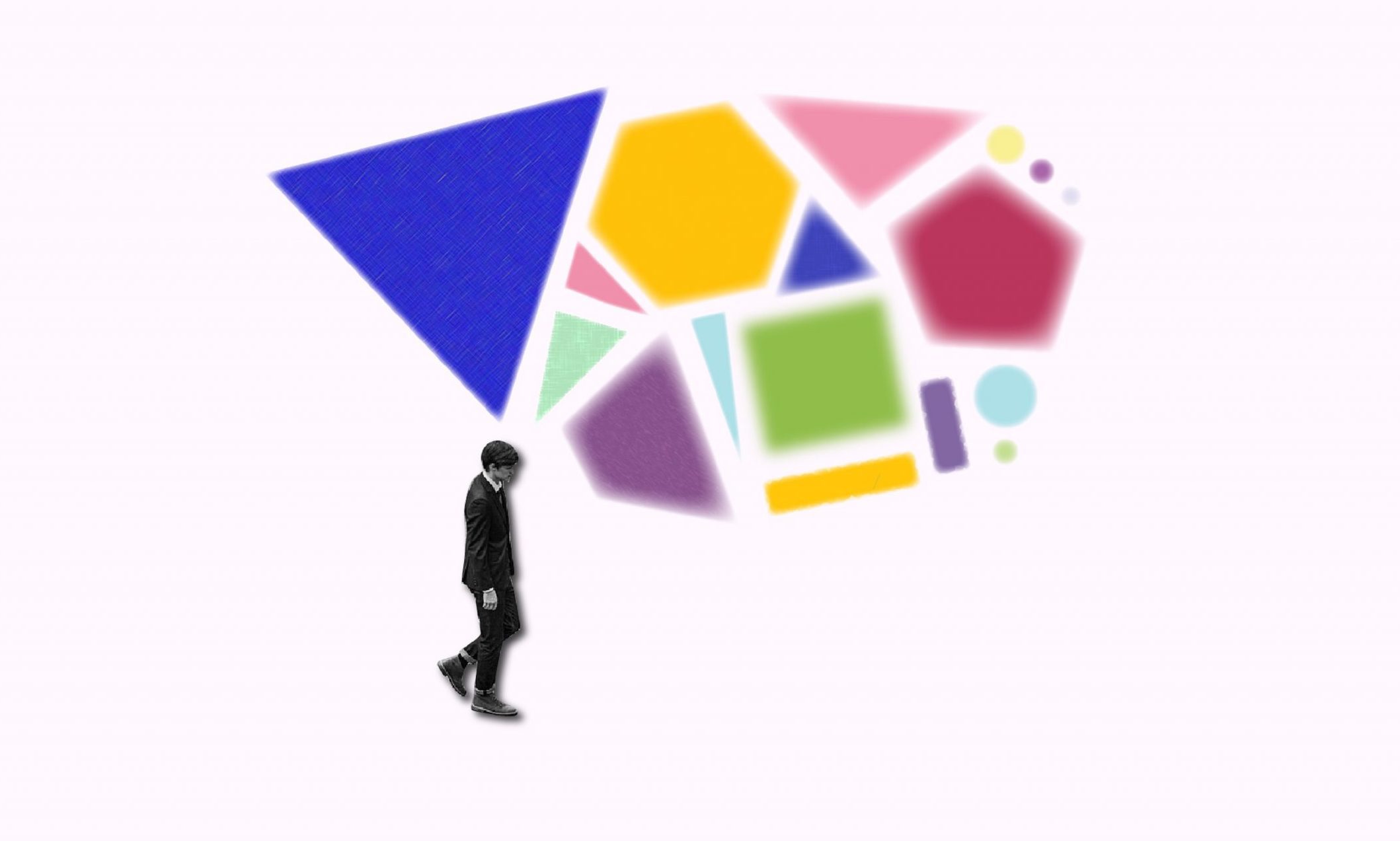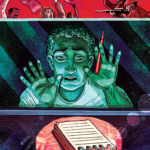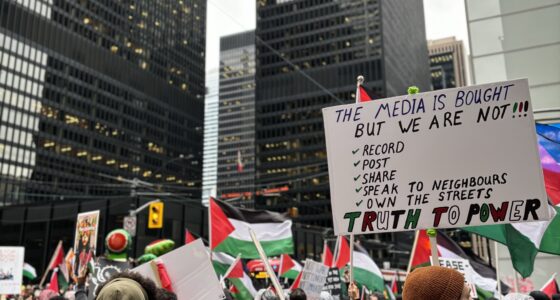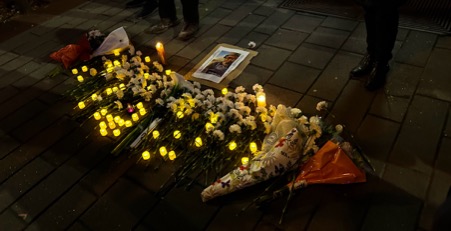How Canadian photojournalists are documenting the COVID-19 pandemic from a distance
Todd Korol stood across the street, about 100 feet away, from the pair of artists he was photographing for the Globe and Mail. Because of physical distancing measures, the space between Korol and his subjects, Rich and Jessica Theroux, was much further than he was used to. At first, Korol tried to direct the shoot over a phone call, cocking his cell phone between his shoulder and ear while holding the camera with both hands. After struggling with this, he decided that yelling out to his subjects would be easier. With the street mostly empty in the early days of the pandemic, Korol raised his voice, directing the couple as they stood on the roof of their drop-in artist studio, downtown Calgary’s Rumble House. (The studio had then just temporarily closed due to COVID-19, with scheduled events, including workshops and auctions, moved online.)
In the photo, a spray-painted black and blue heart can be seen on the front of the studio, the words “every Wednesday” behind it, promoting the space’s weekly community gathering, now on hold until further notice. Under normal circumstances, Korol would’ve spent time getting to know his subjects before photographing them, and would have shot from a much closer position, likely inside the studio. Given the spatial challenges presented by the pandemic, shooting from across the street was the best he could do.
“The photography is more sterile─a lot colder,” says Korol of adapting his practice to modifications demanded by COVID-19. Still, the image of the pair on the roof captures an unprecedented oddity that is difficult to fully explain in words.
These distant dynamics have become the norm for Canadian photojournalists, who must pivot their process to abide physical distance restrictions put in place by the government, for what is looking like the long term. (According to the Centers for Disease Control and Prevention, this means maintaining a distance of about six feet, or two metres, from others.) Although writers, editors, journalists, and producers now find themselves working from home, photojournalists must go outside to do their work. If photojournalists stopped leaving their houses, this particular moment in history would go unrecorded.
Challenges and workarounds faced by photojournalists like Korol require creative thinking. They also produce images that reflect the unusual, almost unbelievable state of things. When future generations return to the photojournalism of this era, they’ll find images snapped by photographers who had to capture the narrative from afar. The behind-the-scenes process is as compelling as the published result.
“[Photojournalists] have to do this job, but I think we have to do it even more responsibly than anybody else,” says Korol. “There’s no need to get up close to people right now.”
Since the beginning of COVID-19, Korol’s hectic workload has been dramatically reduced. He is down to just two or three assignments a week. When he does go out to take photos, he says, he is extra cautious, maintaining a distance of at least 40 to 50 feet from his subjects. In several instances, Korol’s subjects have been nervous about contracting the virus. Korol has told them to go inside and to peer out the window, so he could shoot from outside.
In March, The New York Times published a photo series titled, “The Great Empty,” made up of beautiful photographs from formerly bustling cities around the world, now vacant of humans—a subway platform in Munich, Germany without any commuters; a beach in Santa Monica, California with just a sole silhouette; the unfilled seats of a concert hall in Moscow, Russia.
“These images are haunted and haunting, like stills from movies about plagues and the apocalypse, but in some ways they are hopeful. They also remind us that beauty requires human interaction,” writes Michael Kimmelman, architecture critic at the Times, in the photo collection’s introduction.
Emptiness has become symbolic. Images of empty streets, empty shelves, and empty restaurants illustrate the public void caused by private isolation. The loneliness that many of us feel at home is amplified in outdoor settings, stripped of human interaction.
From Calgary, Korol assembled his own striking photo series, for the Globe. He captured the city’s famous Peace Bridge, its new public library, and other local views, absent their usual energy. One shot shows an empty movie theatre parking lot on a Tuesday evening, with only a single street light illuminating the dark sky. (Movie theatres in Alberta have been closed since March 16.)
“There are very few people, there are very few cars driving, you can look into the office buildings and they’re all dark. It’s very foreboding,” says Korol of the series, which he photographed at the end of March.
Like Korol, Evan Mitsui, a CBC photojournalist based in Toronto, is also taking extraordinary precautions right now. He stands at a significant distance from anyone he is photographing, and stores his equipment in the garage so that he doesn’t risk contaminating his home environment. When he shoots portraits of people who have been diagnosed with COVID-19, or in environments of high transmission risk, such as testing facilities and hospitals, he changes his clothes in the garage, too. He washes his hands constantly.
Mitsui’s style is normally portraiture. This has been heavily impacted by physical distancing measures.
“You kind of develop a relationship with the person,” he says, explaining that in pre-pandemic conditions he would get to know his subject before shooting their portrait. Now, he can only text them and speak by phone.
Many of the images Mitsui has taken during the pandemic have been shot from a distance—a stranger walking down the street wearing a mask and gloves, for example, or an airport worker sanitizing an escalator. “I’m not much of a street photographer, so that element is very new to me… just getting people on the street you may not ever have any contact with again,” says Mitsui.
Korol shares a similar sentiment. He says that photojournalism is about people and their stories. A big part of his process is understanding someone’s situation first, then trying to translate that into an evocative photo. That’s a lot harder now.
“There’s just not that intimate connection anymore, where you can spend time with people and try to capture unguarded moments, through which you capture the essence of them and their situation,” says Korol. “The pictures are changing. You don’t have the same connection with people.”
In Los Angeles, photographer Pascal Shirley decided to vertically distance himself from the city. By helicopter, he aerially photographed LA during stay-at-home orders. One image shows Dodger Stadium converted into a COVID-19 testing centre. The famous “Urban Light” installation at the Los Angeles Contemporary Art Museum was captured without a single selfie-taker in sight. Beaches, playgrounds, parking lots, even the freeway—eerily empty from above.
In late March, Halifax-based writer and photojournalist Matt Williams started a photo series called “Faraway Nearby,” named after the way artist Georgia O’Keeffe signed off her letters to loved ones. For the series, Williams takes portraits of his friends outside their houses, on their doorsteps, or on their porches. He then posts the shots to his Instagram account. He refers to this practice as “house-call portraits,” because he drives to his friend’s homes. (He shoots from at least six feet away.) The captions that accompany each photo affectionately describe the subject’s personality and pursuits—an ode to friendship at a time when sustaining relationships is complicated.
Further north, Pat Kane, a photographer based in Yellowknife, Northwest Territories, started the Isolation Portrait Project to document individuals and families in self-isolation. With a shared creative vision, a group of photographers, mostly from Northern Canada, have spent the duration of the pandemic capturing portraits of people through their windows, on their balconies, and at their doorsteps. These images present a glimpse into the unique experience of isolation in the North. The Atlantic published a short documentary about the project. “It’s almost a duty for me to go out and photograph our own world here,” Kane says in the documentary, “and encourage other people here to tell their own stories.”
Iqaluit-based Lisa Milosavljevic is part of this group of photographers. Many of her upcoming projects had to be cancelled in order to comply with COVID-19 safety measures. Milosavljevic decided to use this newfound time in her schedule to take photos of life in Iqaluit during the pandemic.
“It’s creating a record of what’s happening, but also strengthening the community locally,” says Milosavljevic. She explains that the portraits have an uplifting spirit. They illustrate that everyone is going through the same thing, just apart. Milosavljevic says it’s also important for people in other parts of Canada to see that communities in the North are going through a similar experience with them.
“I think people have a very abstract idea of [the North],” says Milosavljevic. “Having a shared connection will bring a lot more context to people.”
Milosavljevic has encountered some challenges, though. Being outside for a long time makes her fingers and gear very cold, she says. (In April, Iqaluit’s temperature drops to around -20 degrees Celsius.) Window glare is another struggle. “With the light at this time of year, we have these really, really long sunsets, which sounds great, but the sun is horizontal. And if I have a window, that faces the full glare for about four hours,” says Milosavljevic.
Weather and lighting hurdles aside, Milosavljevic is thankful to the people who have allowed her to photograph them in their homes. Documenting this strange, collective experience provides a way to share the Iqaluit community with the rest of the country, and creates connection, despite the distance.
Perhaps one day, when we look back at the photos from the pandemic, it won’t just be the emptiness we remember, but the ways we filled the space.






